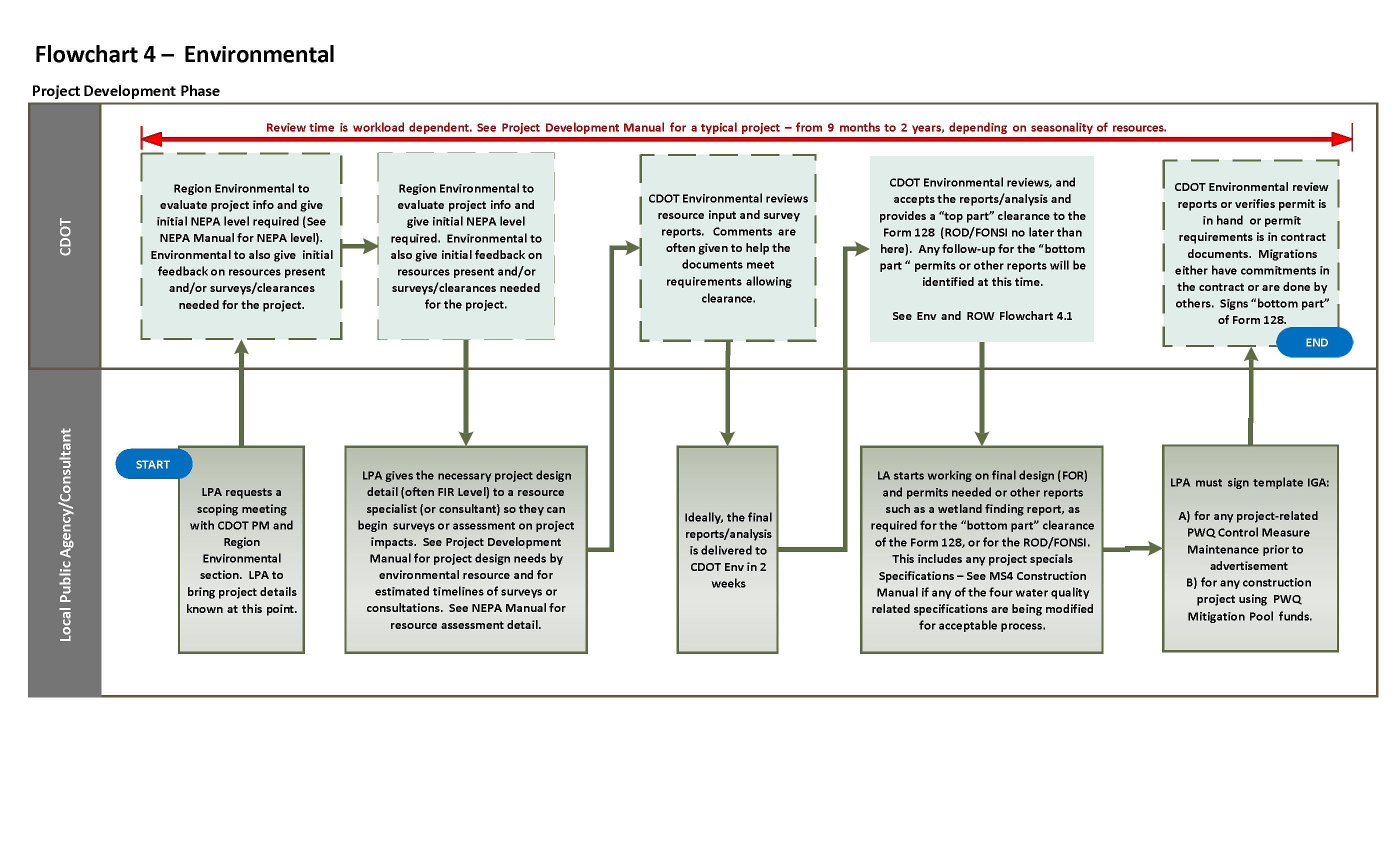Flowchart 4: Environmental Clearance

Download Flowchart 4 (PDF) Download the Flowchart 4 Checklist
Flowchart 4 Project Development Phase Information
Review time is workload dependent. Refer to Project Development Manual for a typical project timeline: from nine months to two years, depending on seasonality of resources.
- To initiate the environmental process LPA must request a scoping meeting with your CDOT project manager and region environmental manager. LPA will need to bring project details known at this point to the meeting and should use the NEPA scoping meeting checklist for this meeting, found on the CDOT NEPA Tools website.
- CDOT region environmental will evaluate the project information you provide and determine the initial NEPA level required. CDOT environmental will also give initial feedback on resources present in the project area and/or surveys/clearances needed for the project. The review time is workload dependent and may not occur during the scoping meeting. Refer to the CDOT's NEPA Manual for an explanation of NEPA level.
- LPA must provide the necessary project design detail, often 30 percent design (FIR level), (but may be more for a historic clearance) to a resource specialist or consultant so they can begin surveys or assessment on project impacts. Refer to the CDOT's NEPA Manual for project design needs by environmental resource, estimated timelines of surveys or consultations, and resource assessment detail.
- CDOT environmental reviews resource input and survey reports. Comments are often given to help the documents meet requirements to allow clearance and may require additional effort by your agency. Review time by CDOT environmental is workload dependent.
- If LPA has adequately addressed the comments and additional requirements, these revised reports are the final reports/analysis and can be accepted by CDOT. Refer to the CDOT's NEPA Manual for resource detail necessary for this analysis.
- CDOT delivers the top part or box B signature on the Form 128 (Catex form) for this level of project design. This step may still need to be verified if you have a NEPA Record of Decision for an EIS or a Finding of No Significant Impact (FONSI) for an EA. CDOT will help identify the "bottom part" of the 128 requirements that may include required permits or other reports that will be necessary to complete the environmental clearance process.
- Flowchart 4A: Environmental and Right-of-Way (ROW) Options provides information on how you might be able to purchase ROW prior to completing the environmental clearance process.
- LPA starts working on final design, required mitigations, permits or other reports such as a wetland finding report, as required for the "bottom part" clearance (box E) of the Form 128. This includes any project specials specifications.
- Refer to the CDOT's MS4 Construction Program Manual if any of the four water quality related specifications are being modified for acceptable process and for the stormwater management plan checklist that ensures all required information is included.
- Review the CDOT's NEPA Manual for requirement details.
- Refer to the CDOT's MS4 Construction and Permanent Water Quality Manuals for the water quality-related specification change process and MS4 Permanent Water Quality requirements.
- You must sign a template IGA for:
- Any project-related permanent water quality (PWQ) control measure (CM) maintenance prior to advertisement; or
- Any construction project using Permanent Water Quality Mitigation Pool funds.
- Refer to the CDOT's MS4 Construction and Permanent Water Quality Manuals and Permanent Water Quality website for details on the permanent water quality control measure requirements or for the use of the $6.5M/year PWQ Mitigation Pool funds available to local agencies in partnership with CDOT.
- CDOT environmental reviews reports, verifies the permit is in hand or permit requirement is in the contract documents. Mitigations either have commitments in the contract or are done by others. CDOT signs the bottom part or box E of CDOT Form 128. Please remember that this is not the end of your environmental requirements. The project must complete these mitigations and comply with all permits, including the stormwater construction permit, during construction.
